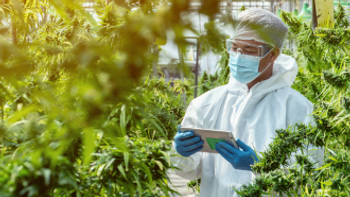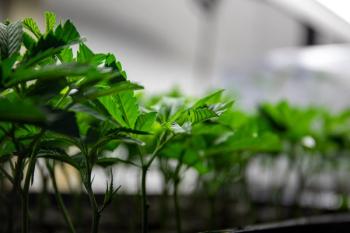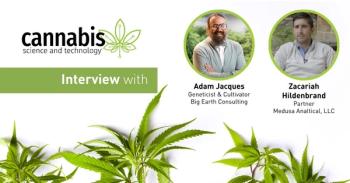
Cannabis Science and Technology
- September/October 2024
- Volume 7
- Issue 5
- Pages: 30-33
More and Better Grow Options Emerging

A look at how growers explore the possibilities of a more manageable operation as research about soil chemistry takes center stage.
Growers explore the possibilities of a more manageable operation as research about the chemistry of the soil takes center stage.
Growing cannabis has been an ongoing experiment across the world for thousands of years, but sharply increasing with the legalization of recreational cannabis in certain jurisdictions around 2014. More discoveries about microorganisms in soil (or using no soil at all) and other post-harvest options are emerging all in an effort to grow faster and more economically with a better quality outcome.
Growing cannabis today is about accessing and applying more mainstream agricultural techniques and processes in the soil composition, in the grow methodologies, and in the post-harvest development.
An accelerated cultivation evolution is happening, with the exploration of such old-but-new-to-cannabis growing technologies as aeroponics challenging hydroponics, even as research into the composition of soil has become focused on the value of bacterial fungi systems for both soil and non-soil-based grows.
This installment of the “Tech Innovations” column will discuss how growers can manage nutrient development of the plant’s soil highway; why using no soil or water at all may provide the best way to control growth, and eventually precisely replicate, a specific cultivar; as well as better ways to dry or cure the plant.
The Soil Food Web System
The cannabis plant, as most common plants, uses a system of nutrient uptake for its specific needs, including mechanisms to effectively “mine” the soil for nutrients (1).
The author of many books on growing, such as Teaming With Microbes: The Organic Gardener’s Guide To The Soil Food Web (2), lawyer and garden writer, Jeff Lowenfels (3) describes the basic function of a plant’s nutrition uptake. “The basic system for the plant, whatever kind of plant it is, puts out an exudate (carbon-rich materials often sticky to human touch that helps stabilize soil and interactions with other organisms around the roots [4]), takes photosynthetic energy and makes these chemicals that it drops out through the root system,” said Lowenfels. He further explained how, “It attracts bacteria and fungi. The bacteria and fungi eat the carbon that are in these exudates, and they attract nematodes and protozoa who eat the bacteria and the fungi. So, you get a lot of eating going on, and then you got a lot of pooping going on.”
What's “pooped” out, he said, are plant usable nutrients, or nutrients in a form the plant can take up. “The microbes put an electrical charge on these nutrients, and that's how they get into the plant,” Lowenfels mentioned. “The exudates can be changed for the plant to get what it needs.”
For example, in cannabis, the plant requires a certain kind of bacterial fungal system, and the exudates are adjusted by the cannabis plant itself to be able to meet the needs of the plant for the nutrients that the plant's going to take in.
Lowenfels said that there are two other things going on. “Some of these exudates attract mycorrhizal fungi, which are different kinds of fungi. They actually go into the root and take the exudate, and in return for the exudate they give the plant water, phosphorus, nitrogen, zinc—basically all sorts of good stuff. If the fungi doesn't give the cannabis plant the good stuff, it doesn't get the nutrients from the cannabis plant. So, it's a symbiotic relationship.”
Loops In The System
There are three different loops in the system where the cannabis plant gets its nutrients: the aforementioned poop loop, which is the basis of the soil food web discovered by soil biology pioneer Elaine Ingham where things are eating and then pooping in plant-usable form (5); the fungal loop, where mycorrhizal fungi had an impact; and the bacteria loop.
According to Lowenfels, that last loop “is very new stuff,” that has “only been known about since 2017, and only really known about what is really going on since 2020.”
Under that system, some of the bacteria that are attracted by the exudates aren't eaten and pooped out, but rather move directly into the root. To protect themselves from the activity that occurs in the cell when they move in, they end up improving the plant’s nitrogen uptake. “By fixing that nitrogen, they're able to spray the inside of the cell and protect themselves,” Lowenfels said. “So, they fix nitrogen inside the root (6), which is a third way of getting nutrients to the plant, and those are endophytic bacteria, or plant beneficial bacteria (7), that feed the plant.”
The key thing about growing cannabis is that a lot of the bacteria and some of the fungi are carried in the seed, noted Lowenfels. If a grower takes the seed and mistreats it, such as sterilizing it, that impacts some of the bacteria that would have jumped out of that seed once it germinated. “So, you reduce the kinds of bacteria that the cannabis plant wants,” he explained.
Sterilizing the seed ends up screwing up the development of the plant. But there are other methods that affect the plant nutrition process. “Growers do things like taking a cannabis seed and putting it in a wet paper towel to get it to germinate,” Lowenfels illustrated. “Once it germinates, they put it in the soil. The problem is that a lot of the bacteria have jumped off that seed during germination. It stays in the towel. So, you’ve got to bury part of the towel as well.”
The soil-food web system is all about the workings of bacteria and fungi. The bacteria adhere particles of soil to one another and begin soil structure formation. “When you grow cannabis, people tell you to throw the soil away. They say that you got to start with new soil all the time,” said Lowenfels.“This is all BS, because if you follow the soil food web system, and you do what you're supposed to do, such as teaming with the microbes, you populate your soil with the right microbes and help build the soil structure. If you reuse the soil, you end up with soil that's got a lot of the exudates in it that the plant needs. Why are you throwing it away?”
What he recommends is making a new hole in the previously used soil, putting the new plant in and letting it grow right in the root system of the old plant. “The soil has all the exudates; it's got all the bacteria. It's got all sorts of amoebas and all the protozoa you'd ever want to have, and it's got these tunnels that are already drilled that the roots can grow into.”
New Systems
A useful new tool mentioned by Lowenfels is the Microbiometer (8). This is a testing kit supported by an app, which is a new way of testing for microbial biomass and fungal bacteria ratio to determine the health of the soil. Data gathered with each testing helps a grower see if their soil management practices are working. “We're getting to the point now where we've got a complete database of all of the life in the soil,” he said. “It's just a question [of] how do you and I as lay people read what's in our soil to compare to that database. We're beginning to get people working on cell phone apps and things like that.”
Aeroponics Update
More recently, there have been researchers investigating aeroponics as a viable process of growing plants without soil in an air or nutrient mist environment. Aeroponics allows plants to have 100% access to CO2 for photosynthesis, and use 70% less water than hydroponics, according to an article (9) in Modern Applications of Plant Biotechnology in Pharmaceutical Sciences.
Aeroponics has been used to grow lettuce, tomatoes, and cucumbers since the late 1990s. But it’s becoming a more interesting method of growing plants, including cannabis.
Kurt Livesay is the owner of Dynamite AG (10), a plant research and consultancy company, and a certified crop adviser through the American Society of Agronomy. He said that in the early days of cannabis cultivation, such as 2015 to 2019, there was talk of growing in a sterile environment, (i.e., no microbiology present in the grow), “which I think is, in retrospect, absolutely absurd,” Livesay expressed. “Now there's all kinds of studies coming out about the aeroponic rhizosphere.”
Rhizosphere has been described as the volume of soil influenced by roots but may also be extended to describe root–soil interfaces (11). They are complex and highly dynamic environments, according to an article in Trends in Plant Science, where an immense number of interactions between roots, minerals, organic compounds, solutes, gases, and micro-organisms drive the biogeochemical cycling of elements (11).
So, there is still microbiology in aeroponics, Livesay said, and it's considerably different than a soil-based media. “The rhizosphere itself is even different than what's in the recirculating nutrient solution. So, it is by no means a sterile environment. And people are saying, oh, you know, it's disease free. Well, the hell it is. Nothing is disease free. But can it substantially reduce some of these risks? Yes, absolutely. That part is true.”
Aeroponics—Not Hydroponics
Aeroponics is more efficient than hydroponics, according to Livesay, but the jury is still out on the best system to use. He explained, “In hydroponics, there is a lot of water-to-root contact. A grower could create an anaerobic environment (which is the lack of free oxygen [12]), and can drown those plant roots. It happens all the time in commercial agriculture, where we don't have enough oxygen there. That’s a fairly common problem with hydroponics. But that is something you never have to worry about with aeroponics, because they're constantly in oxygen.”
One of the challenges of the aeroponic system is the actual size of the water droplets. “It’s about how small of a droplet are we getting to the roots themselves. Because the smaller the droplet size, theoretically, the easier the uptake,” said Livesay.
The early research on aeroponics dates back to the 1950’s, said Livesay, and it was on coffee and tomatoes. “Aeroponics has been applied predominantly for high value crops, because it is a very capital-intensive venture to start out with,” he explained. “To build a DIY aeroponic system is not that expensive. But to have the kind of control over it that commercial growers are going to seek and actually need, it gets stupid expensive.”
What kind of controls? “They're doing things like fertigation schedules (where nutrients are injected through an irrigation system [13]) through that mist. That nutrient solution that we’re spraying on there, it’s not just water,” said Livesay.
A study published in Frontiers in Plant Science (14) emphasizes the significance of fertigation schedules: “Our findings emphasize the need for precise nutrient management strategies in cannabis cultivation. Adjusting nutrient regimens in different fertigation systems yielded significant outcomes,” the study concluded.
According to Livesay, a grower has to figure out if they are going to leave this system running all the time. Are they going to spray it for five seconds every hour? Are we going to spray it for an hour every 24 hours? “Figuring that out is key,” he noted.
The water solubility, and the nutrients that they’re putting in there, are other controls a grower needs to know. “The problem is that it's all based on electrical conductivity (EC),” Livesay lamented. Electrical conductivity, also called EC, is a measure of a material's ability to conduct an electric current often used to assess the concentration of ions or dissolved substances in a solution or to evaluate the purity or quality of water (15). “EC has got to be the stupidest freaking thing that we've come up with in agronomy in general, whether we're talking commercial or hydroponic, controlled environment, whatever. It is one of the dumbest measurements we've ever come up with, because it makes us overconfident and doesn't actually tell us anything.”
Livesay further added, “I don't think that you need to be, necessarily, a botanist or a horticulturalist to be able to use aeroponics. But I do think to be able to dial it in a way to really maximize the potential of it requires a lot of math.”
Burping Is Not The Cure
Once the plant has grown, there are different techniques for curing it. One of those methods is burping, which is the process of releasing the CO2 and moisture and introducing fresh air as the plant cures. “Burping sucks,” said Ed Rosenthal who is a leading cannabis horticulture authority, author, educator, social activist, and legalization pioneer who was one of the co-founders of High Times Magazine. “There is no right kind of burping, because when you're keeping moist marijuana in an enclosure, you're inviting bacteria, and that actually destroys many of the terpenes.”
He discussed using TerpLock (16), a curing product from Grove Bags. TerpLock pushes out excess moisture and oxygen without damaging terpenes, according to its website, allowing both the cannabinoids and terpenes to mature. A grower puts dried flower into the bag, leaving about 25% empty as headspace, seals it, and lets it sit for two weeks to as much as two months for optimal potency.
Curing cannabis is not as easy as people think. “People talk about curing cannabis, but I think that there have to be more studies on that,” said Rosenthal. “There are several things that are happening as cannabis ages in one way or another. One is that some of the terpenes, especially the small molecular terpenes, evaporate pretty quickly, especially if the temperature is above 70°F.”
There is also oxygenation going on. “The terpenes actually change in the presence of oxygen,” he stated. “They change from one kind of terpene to another. I think that happens a lot, and that really hasn't been studied. If you're in a room where there's curing going on and there's a deep, deep smell of terpenes in the room, those are the terpenes that are no longer on the plant.”
The idea is to keep those terpenes on the plant, and that can be done by lowering the temperature. “The ideal ‘drying’ would be something like 68°F with a 30% humidity.”
Cost Effective Cultivation On The Way
No matter what you are growing when, and how you want to refine the process, there is a broader industry need to re-engineer how it works. “I'm not talking about today or next year necessarily, but I think that ultimately, it's a lot easier to brew beer than it is to grow cannabis,” said Rosenthal. “Growing cannabis requires all this expensive equipment that just isn't required in making beer. So, I think that at some point, most tetrahydrocannabinol (THC) is actually going to be produced in yeast that has had THC added to the genetic profile. You will be able to grow a whole crop of THC in four or five days without lights, without planting, without anything.”
Here’s how it could work: A grower would buy an inoculant with yeast that produces THC and some yeast that produces cannabidiol (CBD). Different yeast gives the grower some different terpenes. You then boil a pail of sugar water, drop in yeast, which is basically what you use to brew beer, and five days later, you refine the THC from the water using a home distillation unit.
Conclusion
Soil chemistry, growing options, curing—all concepts that are developing and on the move in research circles to get a better cannabis product that requires less guesswork, and results in more planned outcomes. “The longer you have a mono crop, the greater the likelihood of you bringing disease pressure into that,” Livesay said. “So, biodiversity is important. When we're doing aeroponics, we do have a greater degree of control over that.”
Growers know that this amazing plant that can heal itself and communicate with other plants. “When you walk up to a cannabis plant and you touch the cannabis plant, that entire plant knows you're there, because every cell talks to every other cell,” explained Lowenfels. “There's no question that when certain bugs hit a cannabis plant, the cannabis plant in the next tent over gets a signal: ‘You better prepare yourself for that bug coming.’ Chemical signals and pheromones need to get shifted around.”
Simpler grow processes could make cannabis a more accepted agricultural product for the masses. “I think that as (cannabis) becomes more and more accepted by society, we're going to see more and more people planting it in the same way that they would tomatoes or any other vegetable that they had in their garden,” Rosenthal said. “It will be part of their gardening program.”
References
- Connolly, E.L.; Morgan, J. B. Plant-Soil Interactions: Nutrient Uptake. Nature Education Knowledge, 2013, 4(8):2.
https://www.nature.com/scitable/knowledge/library/plant-soil-interactions-nutrient-uptake-105289112/ (Accessed September 2, 2024). - Lewis, W; Lowenfels, J. Teaming with Microbes: The Organic Gardener’s Guide to the Soil Food Web - Revised Edition. Timber Press, 2010.
https://www.hachettebookgroup.com/titles/jeff-lowenfels/teaming-with-microbes/9781604692549/?lens=timber-press . - Biography of Jeff Lowenfels.
https://www.jefflowenfels.com/books-by-jeff-lownfels/ . (Accessed September 1, 2024). - Lambert, J.; Santiago-Blay, J. Plant Exudates and Amber: Their Origin and Uses. Arnoldia at Harvard University, 2017, 75(1).
https://arboretum.harvard.edu/stories/plant-exudates-and-amber-their-origin-and-uses/ (Accessed September 1, 2024). - Biography of Elaine Ingham.
https://www.soilfoodweb.com (Accessed September 1, 2024). - Wagner, S. C. Biological Nitrogen Fixation. Nature Education Knowledge, 2011, 3(10):15.
https://www.nature.com/scitable/knowledge/library/biological-nitrogen-fixation-23570419/ . - Afzal, I; Shahzad, S.; Shinwari, Z.; Sikandar, S. Plant beneficial endophytic bacteria: Mechanisms, diversity, host range and genetic determinants. Microbial Research, 2019, 221, 36-49.
https://doi.org/10.1016/j.micres.2019.02.001 . - Microbiometer product website.
https://microbiometer.com/ (Accessed September 1, 2024). - Buckseth, T.; Muthuraj, R.; Pandy, K.K.; Sharma, A.K.; Singh, B.P. Methods of Pre-Basic Seed Potato Production with Special Reference to Aeroponics—A Review. Scientia Horticulturae, 2016, 204, 79-87.
https://doi.org/10.1016/j.scienta.2016.03.041 . - Website for Dynamite Ag.
https://dynamiteag.com/about (Accessed September 1, 2024) - Oburger, E.; Schmidt, H. New Methods to Unravel Rhizosphere Processes, Trends in Plant Science, 2016, 21(3), 243-255.
https://doi.org/10.1016/j.tplants.2015.12.005 . - Elgamal, A.A. Anaerobic Environments. Encyclopedia of Earth Sciences Series, 2015.
https://doi.org/10.1007/978-94-017-8801-4_158 . - Malik, M.; Senkyrik, J.; Tlustos, P.; Velechovsky, J. Effect of Augmented Nutrient Composition and Fertigation System on Biomass Yield and Cannabinoid Content of Medicinal Cannabis (Cannabis sativa L.) Cultivation. Frontiers in Plant Science, 2024.
https://www.frontiersin.org/journals/plant-science/articles/10.3389/fpls.2024.1322824/full . - Malik, M.; Senkyrik, J.; Tlustos, P.; Velechovsky, J. Effect of Augmented Nutrient Composition and Fertigation System on Biomass Yield and Cannabinoid Content of Medicinal Cannabis (Cannabis sativa L.) Cultivation. Frontiers in Plant Science, 2024.
https://www.frontiersin.org/journals/plant-science/articles/10.3389/fpls.2024.1322824/full . - Website for EC Meter.
https://www.westlab.com (Accessed September 1, 2024). - Website for TerpLock.
https://grovebags.com/curing-with-terploc/ (Accessed September 1, 2024).
About the Columnist
David Hodes has written for many cannabis publications, and organized or moderated sessions at national and international cannabis trade shows. He was voted the 2018 Journalist of the Year by Americans for Safe Access, the world’s largest medical cannabis advocacy organization.
How to Cite This Article
Hodes, D., More and Better Grow Options Emerging, Cannabis Science and Technology, 2024, 7(5), 30-33.
Articles in this issue
about 1 year ago
Calibration Science, Part VI: Validationabout 1 year ago
Rescheduling Cannabis: Are We Entering A New Era?about 1 year ago
Croptober: The Challenges of Outdoor Cannabis Cultivationabout 1 year ago
A Better Cannabis Product Testing SystemNewsletter
Unlock the latest breakthroughs in cannabis science—subscribe now to get expert insights, research, and industry updates delivered to your inbox.





